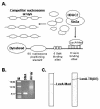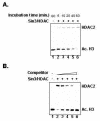An in vitro assay to study the recruitment and substrate specificity of chromatin modifying enzymes
- PMID: 15282629
- PMCID: PMC491765
- DOI: 10.1251/bpo85
An in vitro assay to study the recruitment and substrate specificity of chromatin modifying enzymes
Abstract
Post-translational modifications of core histones play an important role in regulating fundamental biological processes such as DNA repair, transcription and replication. In this paper, we describe a novel assay that allows sequential targeting of distinct histone modifying enzymes to immobilized nucleosomal templates using recombinant chimeric targeting molecules. The assay can be used to study the histone substrate specificity of chromatin modifying enzymes as well as whether and how certain enzymes affect each other's histone modifying activities. As such the assay can help to understand how a certain histone code is established and interpreted.
Figures



Similar articles
-
Histone-modifying enzymes: encrypting an enigmatic epigenetic code.Curr Opin Struct Biol. 2006 Dec;16(6):753-60. doi: 10.1016/j.sbi.2006.10.002. Epub 2006 Oct 27. Curr Opin Struct Biol. 2006. PMID: 17070031 Review.
-
Modifying Chromatin by Histone Tail Clipping.J Mol Biol. 2018 Sep 14;430(18 Pt B):3051-3067. doi: 10.1016/j.jmb.2018.07.013. Epub 2018 Jul 25. J Mol Biol. 2018. PMID: 30009770 Review.
-
Substrate Specificity Profiling of Histone-Modifying Enzymes by Peptide Microarray.Methods Enzymol. 2016;574:31-52. doi: 10.1016/bs.mie.2016.01.008. Epub 2016 Feb 16. Methods Enzymol. 2016. PMID: 27423856 Free PMC article.
-
In vitro assays to study protein ubiquitination in transcription.Methods. 2002 Mar;26(3):233-44. doi: 10.1016/S1046-2023(02)00027-0. Methods. 2002. PMID: 12054879
-
Role of Histone-Modifying Enzymes and Their Complexes in Regulation of Chromatin Biology.Biochemistry. 2016 Mar 22;55(11):1584-99. doi: 10.1021/acs.biochem.5b01210. Epub 2016 Jan 26. Biochemistry. 2016. PMID: 26745824 Review.
Cited by
-
Two functional modes of a nuclear receptor-recruited arginine methyltransferase in transcriptional activation.Mol Cell. 2006 Oct 20;24(2):233-43. doi: 10.1016/j.molcel.2006.09.020. Mol Cell. 2006. PMID: 17052457 Free PMC article.
-
A combinatorial H4 tail library for exploring the histone code.Biochemistry. 2008 Aug 5;47(31):8094-102. doi: 10.1021/bi800766k. Epub 2008 Jul 11. Biochemistry. 2008. PMID: 18616348 Free PMC article.
-
Affinity-based enrichment strategies to assay methyl-CpG binding activity and DNA methylation in early Xenopus embryos.BMC Res Notes. 2011 Aug 18;4:300. doi: 10.1186/1756-0500-4-300. BMC Res Notes. 2011. PMID: 21851637 Free PMC article.
References
-
- Becker PB, Horz W. ATP-dependent nucleosome remodeling. Annual Review of Biochemistry. 2002;71:247–273. - PubMed
-
- Fischle W, Wang Y, Allis CD. Histone and chromatin cross-talk. Current Opinion in Cell Biology. 2003;15:172–183. - PubMed
-
- Jenuwein T, Allis CD. Translating the histone code. Science. 2001;293:1074–1080. - PubMed
-
- Kundu TK, Palhan VB, Wang Z, An W, Cole PA, Roeder RG. Activator-dependent transcription from chromatin in vitro involving targeted histone acetylation by p300. Molecular Cell. 2000;6:551–561. - PubMed
LinkOut - more resources
Full Text Sources
Research Materials

